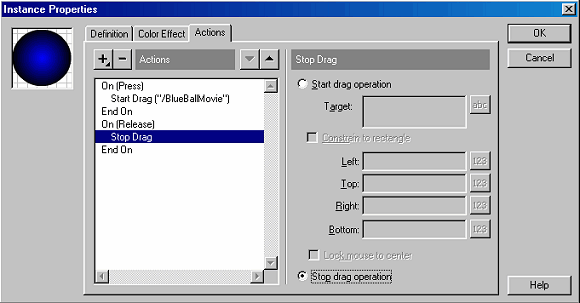I was a Director developer, who tried FutureSplash Animator in 1996 and couldn't take it very seriously. I regarded it as a toy. We had afterburner and then shockwave, which could do so much more. Director's scripting language was never highly regarded, with the latinate genitives of children, "silly" metaphors like puppets and casts, but it had powerful, dynamic LISP-like features, a command-line, acceptable OOP, and it compiled to bytecode. You could do great things with it. (Most of the really great Director stuff - such as the Voyager CDROMs - was overlooked, or made for very small audiences such as museum visitors). The early 'action' editors in Flash were a bad joke.
 |
| Programming with Oven Gloves on - The Flash 4 Actions Editor |
I was even more amazed that, as ActionScript 2 appeared, offering a classical OOP model, a handful of people started using it to make some quite decent casual games, and, with ActionScript 3 even emulators, synthesisers and some fabulous data visualisation tools (e.g. gapminder). Slowly, steadily, it became more technically powerful, and certainly more up-to-date than its older stepbrother.
I switched to Flash, even began teaching it, and developed a couple of solid medium-size applications with it, plus many small things. I adopted AS3 and grew to like it. I marvelled at the brio with which sensitive creative types took to "serious" computer science topics like strict typing, protected members and event bubbling.
But there has never been any doubt that Flash - authoring and playback - has been rotten on Apple's systems for almost 10 years. Crashes, hangs, lousy resource management (memory/CPU) and poor OS-integration have been the norm. Multimedia designers - many of whom are Mac users - have always had a love-hate relationship with Flash, and I believe that now they are ready to move on. Steve Jobs' famous letter from 2010 is a fascinating example of rhetoric and technological leadership, to the extent that after barely more than a year, even Adobe has been forced to admit that their flagship technology is sinking.
I confess to a certain amount of schadenfreude. I remember the snooty Flash kids, their tool of choice in the ascendant, looking down their noses at Director devs, just as we looked down our noses at the Hypercard and Authorware community.
And so it becomes increasingly obvious: Closed multimedia authoring systems are always a dead-end, no matter how de facto 'standard' they may temporarily be. Microsoft's never-popular Silverlight - a potential competitor crippled by neurotic strategy - is another relevant example. In each previous case, there was always an obvious proprietary ship to jump to, but that is not so as Flash declines, and that is why Flash and SWF will linger on, way past their sell-by date.
So instead multimedia designers are expected to bank on HTML5 and javaScript. In theory, a great idea. In particular we are offered Canvas, and a fairly ropey, underdocumented audio/video playback API, with various ideological and technical encumberances. (Did you know that iOS can only play one piece of HTML5 audio at a time? Or that Firefox doesn't - and will never - support mp3?)
Now I see an interesting dilemma for multimedia designers and content / front-end developers, who cut their OOP teeth on Java, ActionScript or C#: A mindset migration from strict-typed classical languages, to javaScript - a language which superficially resembles Java / ActionScript / C#, but in truth is more like an exotic variant of LISP. How will the multimedia designers cope with this? How will they adopt javaScript when 99% of javaScript books and web-based tutorials promote dilettante or sub-optimal practice? How will the multimedia design courses teach it? The paradigm shift is going to be interesting to watch, and can only be ugly.
Then there is code editing. Flash's ActionScript editor is not the best editor in the world, but it has some very friendly features which really help you learn. It is, quite frankly, ideal for first-time coders with artistic leanings. Is there a similarly accessible javaScript code editor that offers syntax-checking, automatic code-indenting, friendly error feedback etc.?
Is there a browser which doesn't just give up silently when your javaScript has the tiniest error? Does the browser error console offer much help? The error feedback in Flash authoring has never been amazing, but at least it gives you a clue where to look for problems in your code.
I know that this is total non-problem for comp.sci folks, but the audience for the Flash authoring tool is quite different. They have different needs and different expectations when making interactive stuff. And yes, many of them are crap, and clueless but many really want to make good stuff and adopt best practices.
The landscape for content developers, self-taught game devs, arty-nerds, interaction designers, ux/ui designers etc. for creating javaScript-based content is fragmented and unfocused. Hardcore coders will always be happy with Ultra-edit, or VisualStudio, or Eclipse or notepad++, but those tools will never catch the hearts of the folks that come from an arts or design background.
I also see no other software which has vector drawing tools as friendly and intuitive as those found in Flash since its very first versions, and I see no animation tools that can export lightweight vector-based animations (e.g. svg) for the web. (BTW The animated gif exporter of Flash *really* sucks, and animated gifs are surely not where we want to go in the 21st century).
Also, canvas offers no sprite model, no 'movieclips', no collision detection, ultimately you just have a bitmap which does not distinguish one mouse or touch event from any other, except in pixel coordinates. If you want to keep track of individual visual objects, you have to build your own engine in javaScript, which means performance overheads. There are a few of these engines out there, (see here, here, here and here) some are very good, but it's a terrible shame that some of the features that multimedia designers regard as basic or fundamental ("I want something to happen in the corner of the screen when I click on this moving monster") are simply not available, straight off the HTML-5 shelf.
SWF is undoubtedly on its deathbed, but the Flash authoring tool has no obvious heir. The market is wide open for a "Flash-killer" which offers some, or all of the features mentioned above, which generates HTML5+javaScript, preferably in some editable form, so that it can be hacked about with PHP or whatever afterwards.
Adobe Edge looks promising, but I am wary of Adobe's ability to manage multimedia authoring tool development. Their track record is abysmal. Can they just not screw up, bloat, and hobble their tools with the limitations of their broader strategy for reaching 'internet marketers'? I am sceptical.
And I am training my JS/HTML5 muscles for multimedia teaching and multimedia content production, because as Flash declines, the quality difference between 'the men and the boys' is going to be pretty stark.
Labels: Director, Flash, Multimedia Design, Scripting
1 comments:
Subscribe to:
Post Comments (Atom)

Just discovered this article with a very similar premise
http://www.imediaconnection.com/content/30684.asp